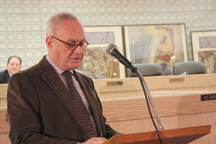A mural created during the Great Depression and gifted to the Bayonne Library has finally found a place for display after spending years in storage.
Created by Maurice Abramson, a local artist as well as a one-time prominent jeweler in Bayonne, the mural is a classic example of works done under the Works Progress Administration, a government-supported program during the Depression to put people to work building projects throughout the country.
“He made a living in jewelry, but he lived for art.” – Vincent Lo Re
________
In arguing the case for displaying the panels, family members said that the paintings reflect an economic crisis in the world very similar to the current situation.
Full of symbolic representations, the painting shows images of a crashing stock market, the image of a bank façade, and rich and poor all seeking aid.
Abramson was an aspiring artist who took over his father’s jewelry business in the 1960s. He retired at age 54 so he could pursue painting full time.
“Although he worked as a jeweler, he never stopped being an artist,” said Allen Abramson, Maurice’s son.
Entitled “The American Dream,” the painting was donated to the library in 1937, where it remained prominently displayed until a 1959 fire. The panels were put into storage temporarily, but did not go on display again until they were unveiled in 1994. They remained displayed for about six years, then put into storage again.
Allen Abramson visited the library about nine years ago, but did not see the mural. A friend of the family visited the library in 2008 and also reported the artwork was not displayed.
Allen wrote to city officials and library staff asking about the missing murals. He said he received no reply.
Library policy, said Joseph Ryan, spokesperson for the city, does not allow permanent exhibits.
Part of history
Ryan said this was a work done as part of the WPA artists’ series, and has historical significance.
“In many ways, the current economic situation has much in common with that era,” he said.
Abramson’s Jewelers was established in 1925 near 22nd Street on Broadway. Maurice took over the business from his father, and specialized in creating original handmade jewelry. Jewelry stores sold a variety of items during those days and even repaired watches. In 1945, the store relocated up the street, where they purchased a street clock from another jeweler. The clock still stands there.
In the early 1960s, the Abramson family sold the business and the building to Al Wein, allowing Maurice to pursue his lifelong ambition to paint. During the 1950s, Maurice had already spent summers at a commune in Central New Jersey, called “Free Acres.”
Maurice studied at the National Academy of Design and Arts Students League from 1930 to 1937. Though classically trained with a rich realistic style that he pursued in oil, drawings, and etchings, his style evolved into non-objective works in oil and collage beginning in the 1960s. He was the winner of the Hallgarten Prize in 1937. His work has been exhibited nationally.
Back on display
A one-time teacher of history, Council President Vincent Lo Re encouraged the city to accept the paintings for temporary display in City Hall.
On Oct. 22, the mayor and several members of the City Council officially welcomed members of the Abramson family to City Hall to unveil the artwork, which will be on display in the City Council chambers until a permanent home can be found – which city officials hope will be in the new Bayonne Community Museum when it opens in the spring.
“The artist was in fact an artist and an art teacher,” Lo Re said. “He made a living, I understand, in jewelry, but he lived for art. He was an artist, a creator, teacher and social commentator. What we see in the panels is very similar to what we see in the real world today – unemployment, economic problems, bank failures and political instability.”
He added, “Many of the artists of the 1930s were paid by the government.”
Mayor Mark Smith celebrated the return of the picture.
“It is appropriate that during this time of economic challenge that we unveil these beautiful works of art, because our nation and our city are facing those same tough economic challenges that were faced when the work was done,” he said.
This art will also be on display on TV each time a public meeting is broadcast on local cable television.
“We’re very proud of our history in Bayonne,” Councilman Ted Connolly said. “And these paintings are very important to us here.”
“Looking at these pictures, I kind of feel that I know this person,” said Councilman Terrence Ruane.
Allen Abramson said his father loved Bayonne and had great pride as a civic and business leader here.
“The mural’s theme is as relevant today as it was 72 years ago. The U.S. still offers hope and opportunity for people to pursue their dreams and their aspirations,” he said. “My father’s deeply rooted optimism in human kind gave him the ability to … transcend obstacles that is powerfully portrayed in this work. Art such as this was the mass media of its day, displayed in public places to inspire hope and dignity for those who lived and endured during that difficult period.”
Maurice, Allen said, gave the city two prominent symbols – this painting and the clock on Broadway.
